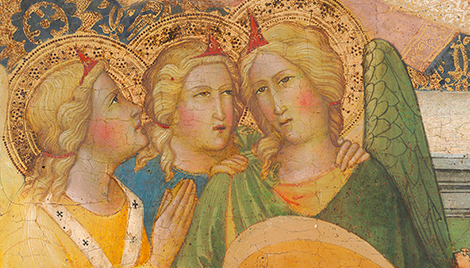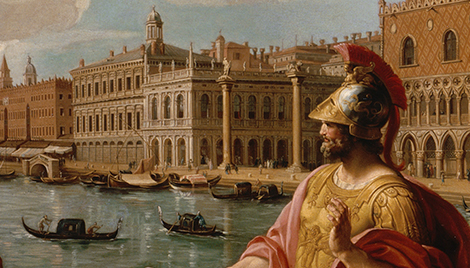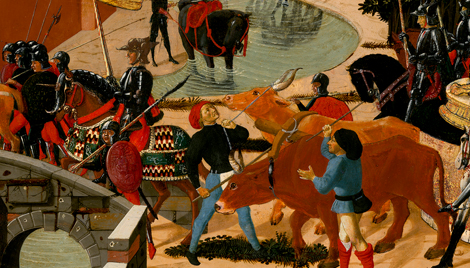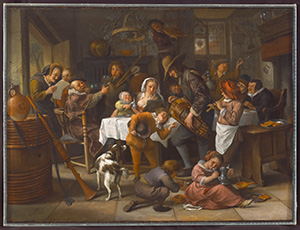Soo de Ouden Songen, Soo Pijpen de Jongen (As the Old Sing, So Pipe the Young)
Soo de Ouden Songen, Soo Pijpen de Jongen (As the Old Sing, So Pipe the Young)
- Artist
- Jan Steen
- Artist Dates
- 1625/1626-1679
- Artist Nationality
- Dutch
- Title
- Soo de Ouden Songen, Soo Pijpen de Jongen (As the Old Sing, So Pipe the Young)
- Date
- c. 1668
- Medium
- oil on panel
- Dimensions
- 44.1 x 60.6 cm (17-3/8 x 23-7/8 in)
- K Number
- K2185
- Repository
- Allentown Art Museum
- Accession Number
- 1961.060.000
- Notes
Provenance
(Possibly Adriaen Swalmius sale, Rotterdam, 15 May 1747). (Possibly van Leer sale, Amsterdam, 19 May 1767). [1] Chevalier Francottay; (his sale, Paris, 20 February 1816, no. 24). Chevalier Sébastien Érard [1752-1831], Château de la Muette by 1828. (John Smith [1781-1855], London); Baron Johan Gijsbert Verstolk van Soelen [1776-1845], The Hague, by 1833. [2] (Henri Héris [b. 1790] Brussels); (his sale, Paris, 26 May 1841). Samuel Jones Loyd Overstone, [d. 1883], 1st Baron, London; [3] by inheritance to Robert James Loyd-Lindsay Wantage [d. 1901], 1st Baron, who married Harriet Sarah, Lord Overstone's daughter and inherited Overstone's estates through her; by inheritance by Lady Harriet Sarah Loyd-Lindsay Wantage [d. 1920]; by inheritance to David Alexander Edward Lindsay Crawford [d. 1940], 27th Earl of Crawford and Balcarres, Haigh Hall, Lancashire. (D. Katz, Dieren) by 1933. Mr. and Mrs. David Birnbaum- ten Cate [later David Bingham, 1891-1956], New York, by 1942; [4] sold 1957 to (Schaeffer Galleries, New York); [5] sold to Samuel H. Kress [1863-1955] on 16 February 1957; gift to the Allentown Art Museum in 1961, no. 1961.60. [1] Karel Braun, Jan Steen, Rotterdam, 1980, no. 153. [2] Nieuw Nederlandsch Biografisch Woordenboek (1933) vol IX, pp.1204-5. [3] It was originally thought that Overstone bought this picture from Verstolk van Soelen estate directly. However, it appears in a 1841 Paris sale of Héris, a dealer from Brussels who was selling for the Verstolk van Soelen estate. [4] List of Birnbaum's collection included with a letter dated 7 August 1942 from Rombout van Riemsdijk of the Netherlands information Bureau to Daniel Catton Rich of the Art Institute of Chicago (Art Institute of Chicago Archives, Daniel C. Rich, Director of Fine Arts 1938-1958, Exhibition Records, Great Dutch Masters Exhibition, RG 505-Box 0063). Birnbaum lent to Dutch Masters of the Seventeenth Century, M. Knoedler & Company, New York, 1945, no. 16 as "The Hurdy-Gurdy" player. Birnbaum changed his name to Bingham in 1946. [5] Shaeffer bought the Steen and the de Keyser Mother and Child together from Mrs. Bingham in February 1957. Schaeffer Galleries Records, Box 2 Client Files, Getty Research Institute.
Catalogue Entry
Jan Steen
Soo de Ouden Songen, Soo Pijpen de Jongen (As the Old Sing, So Pipe the Young)
K2185
Allentown, Pennsylvania, Allentown Art Museum (61.60.G), since 1960. Oil on uncradled oak. 17 3/8 x 23 7/8 in. (44.1 x 60.6 cm.). Inscribed at lower left corner, the monogram: JS teen. The metal bell hanging from the ceiling is inscribed SOO D OVDE ('As the old [sing, so the young pipe]'). This is the beginning of a popular Netherlandish proverb illustrated several times by Steen and by earlier painters.(1) Well preserved. Allentown, 1960, p. 128. Reproduced in color in National Geographic Magazille, CXX, December 1961, p. 823. Seventeen figures are shown in a tavern-like setting; at the left a bass shawm leans against a wine or beer barrel with a jug above; an old woman sings from a music sheet held in both hands; a smiling girl stands at her side; a bearded elder in rich garb raises a rum glass with both hands; a young bagpiper is to the right with a serving maid (seen from the back) at an open cupboard. A smiling baby holds a pipe seated on the lap of her mother who holds a vessel in her left hand, her breast prepared for nursing. A seated man is to the right. A smiling violinist stands on a chair in the background next to the inscribed ivy-entwined bell hanging, with two bird cages, from the ceiling. A group of three elderly people are to the extreme right near the fireplace. A boy playing a recorder stands in the right foreground with a hurdy-gurdy player. A laughing boy, with a spaniel to his right, points toward the instrument. A speelpijp (bass shawm) is at the left. A boy smoking a pipe with a brazier is in the central foreground near a girl with her lips on the spout of a pewter beer pitcher. The Dutch word for a beer pitcher's spout is a pijp, that for smoking pipe is rookpijp, the bagpipe was known as a pijpzakken, the recorder is also a form of pipe. Thus almost all the young figures are engaged with pipes in one form or another while the old folks sing or play, providing a visual play on the proverb: So de ouden singen, so pijpen de jongen'.(2) Smith (IV, p. 16, Cat. No. 151) included the painting in his Steen Catalogue raisonné, noting that ' ... a great variety of objects contribute to enrich the composition of this excellent picture.' Waagen found 'The peculiar humor of the master appears in full measure in some of these figures, especially in the organ man; on the other hand, the vulgarity is here and there too exaggerated, especially in the fat baby. In point of solid and careful execution, however, the picture is a first-rate specimen of his art.'(3) Van Westrheene's Steen monograph entitled the painting Une Compagnie Joyeuse.(4) The canvas was reproduced in Bredius's Steen monograph.(5) Hofstede de Groot listed the painting in his catalogue raisonne.(6) The influence of the Flemish master Jacob Jordaens upon Steen was suggested by Martin, who pointed out that Jordaens's renderings of Twelfth Night (close in subject and composition to K2185) must have impressed the younger master. The painters could have met when Jordaens was in The Hague working during 1649-51 on the decorations for the Oranjezaal at the Huis ten Bosch.(7) According to Shapley (Allentown, p. 128), 'Two paintings of the subject in the Mauritshuis, The Hague, show members of the artist's family and actors in the scene, and figures in our painting resemble some in those two closely enough to suggest that in this also members of Steen's family may have served as models. The date is probably c. 1668, the year inscribed on a much larger painting of the subject in the Rijksmuseum, Amsterdam.' Steen is known to have been a music-lover; the fiddler resembles a Self-Portrait (Amsterdam, Rijksmuseum) and another Self-Portrait showing him playing a lute (Lugano, Thyssen Collection).(8) The chronology of Steen's works is not clear. Stechow has noted that relatively few of the smaller works, on panel, are dated, suggesting this may be due to the fact that the artist considered them less important than the larger works on canvas. There is very considerable difference in color between large and small versions of the same composition.(9) The Kress panel corresponds in several details to the larger canvas of the same subject by Steen dated 1668 (Amsterdam, Rijksmuseum). The girl on the floor in the foreground is shown standing in the Amsterdam painting, holding the tankard toward another smaller standing girl. Many of the other models are the same, although the composition is less elaborate in the Amsterdam painting than that of K2185. The composition of the Kress panel combines two subjects often painted by Jordaens as pendants, especially between 1638 and 1640: Twelfth Night (The King Drinks) and Soo de Ouden Songen.(10) Steen also followed Jordaens in using members of his own family as models for these subjects. The Kress panel shows Steen's mastery of an extraordinarily rich, complex use of color with many subtle variations in hue. The mood of the panel stems from Merry Companies of Buytewech and his circle; the free-flowing brushwork may have been partially inspired by Hals. The complex fusion of gaiety and melancholy in this panel is peculiarly appropriate to the theme, which has references to the Memento Mori. Watteau's artistic achievements about forty years later 'Would be unthinkable without such masterful precedents as this panel. Provenance: M. le Chevalier Francottay (sold, Paris, 20 Feb. 1816, pp. 10-12, Cat. No. 24), as Scène familière. M. le Chevalier Erard, Chateau de la Muette, Boulogne. John Smith, London, 1828 (purchased by him from the above), as The Hurdy-Gurdy Player. Baron Verstolk van Soelen, The Hague, 1833. Héris de Bruxelles, Paris, 25 Mar. 1841. Lord Overstone, London, exhibited –Manchester, Art Treasures of the United Kingdom, Loan Exhibition, 1857, p. 59, Cat. No. 770. Sir Robert James Lloyd-Lindsay, Baron Wantage, London, Catalogue (1905), p. 154, no. 220, as Twelfth Night, exhibited –London, Guildhall, 1892, Cat. No. 107, as Twelfth Night; London, Dowdeswell Galleries, A Loan Exhibition of Pictures by Jan Steen, May-June 1909, p. 19, Cat. No. 31, lent by Lady Wantage, as Hurdy-Gurdy Player – 'Soo de Ouden...'. Inherited by the Earl of Crawford and Balcarres in 1920, exhibited – Leyden, Jan Steen Exhibition, 1926, Cat. No. 35. D. Katz (dealer), Dieren, Holland, 1936. Mr. and Mrs. D. Birnbaum, Ten Cate, exhibited –New York, M. Knoedler and Co., Dutch Masters of the Seventeenth Cetltury, 5-24 Feb. 1945, Cat. No. 16; Pittsburgh, Pa., The Carnegie Institute, Pictures of Everyday Life Genre Painting in Europe, 1500-1900, 14 Oct.-12 Dec. 1954, Cat. No. 40, lent by David Bingham, Hartsdale, New York. New York, Schaeffer Galleries. Kress acquisition 1957, exhibited –Washington, D.C., National Gallery of Art, Art Treasures for America from the Samuel H. Kress Collection, 10 Dec. 1961-4 Feb. 1962, Cat. No. 88; Allentown, Pa., Allentown Art Museum, Seventeenth Century Painters of Haarlem, 2 Apr.-13 June 1965, p. 66, Cat. No. 74.(11)
References
(1) The proverb appears in Jakob Cats's Spiegel van de oude en de nieuwe Tijd (1632) on p. 26 of the 1658 edition. See also P. J. Harrebomée, Spreekwoordenboek der Nederlandsche Taal, Utrecht, 1858, I, p. 364, no. 200; II, p. 156. (2) For this imagery in Steen's art see D. Bax, Hollandse en Vlaamae Schilderkunst in Zuid-Afrika, Kaapstad-Pretoria, 1952, p. 56. Musical instruments in K2185 identified by Susan Thiemann and Emanuel Winternitz . (3) Supplement to Gustav Friedrich Waagen, Treasures of Art in Great Britain, London, 1857, pp. 143-4. (4) T. van Westrheene, Jan Steen, Étude sur l'art en Hollande, The Hague, 1856, pp. 115-16, Cat. No. 71. (5) A. Bredius, Jan Steen, Amsterdam, n.d., I, pl. 19. (6) C. Hofstede de Groot, Catalogue Raisonné..., I, Paris, London, Esslingen a.N. 1908, p. 34, Cat. No. 91. He listed fifteen examples of the subject. (7) W. Martin, Jan Steen, Amsterdam, 1954, pp. 29-30. The Kress panel is on p. 82, Cat. No. 66. (8) Reproduced Martin, op. cit., figs. 1, 2. (9) Wolfgang Stechow, 'Jan Steen's Merry Company', Allen Memorial Art Museum Bulletin (Oberlin College, Ohio), XV, 1958, pp. 91-100, esp. pp. 94-5. (10) For such works see Michael Jaffé, Jordaens, The National Gallery of Canada, Ottawa, 1968, pp. 180-9, Cat. Nos. 64-7. (11) K2185 was not in the Swalmius or Leers Collections as previously stated by Hofstede de Groot (op. cit., I, p. 34). It does not conform with the measurements of paintings described in vague terms and possibly identifiable as the Kress panel.






